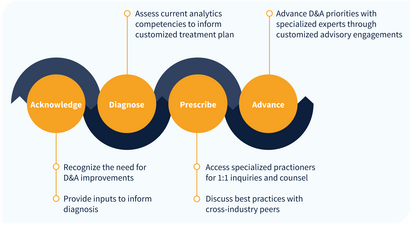Client Inquiry:
We now have a chief data officer (CDO). How did you bring together a new data team and organization under a CDO?
Expert Takeaways:
Data Vision
- Articulate and disseminate the data strategy—a vision of the perfect future—as soon as possible. The initial vision will never be achieved because goals and technology are always changing.
- The CDO is really building a capability that will meet the needs of the business, and that capability is around people, processes, and technology. Understand CDO dependencies on other parts of the business. You will need support from IT and SMEs, and so on.
- When it comes to implementing the vision, aim for incremental change rather than using a big project approach.
- Work tactically into the strategic vision by looking for the business pain and finding out where the CDO organization can add business value immediately. Some business values may be masking dull underlying governance tasks, but it should all build in the same direction.
- CIO vs. CDO. Sometimes there's confusion between information and data. CIOs are responsible for the systems that collect, store, and secure information. CDOs are responsible for the data within those systems.
Data Belongs in the Business
- Position data outside of IT's purview, closer to the businesses, which will make data more responsive to business needs.
- When data is not responsive (as when data access is parsed out by IT), the business units will revert to "bad behavior"—using spreadsheets and older technology such that you may end up with "shadow IT." Shadow IT occurs when ungoverned, unsupported data sets float around the organization.
- Also, because using the CDO group is a budgetary item, the business may push back, insisting they can manage the data themselves for free. To combat this, ensure you have executive buy-in so that says this behavior doesn't fit with the data strategy or vision as approved by the executives.
- Assess how data is being processed and by who. For example, we discovered over 100 employees in the organization who were manipulating data in spreadsheets even though they weren't considered data people. I've put together a business case around this fact—citing inefficient data usage, ungoverned usage, lack of best practices and standards—and what the ROI would be with a complete restructuring with a specialized data team.
- Be pragmatic when transitioning from old spreadsheet-style technologies to new ones such as Azure. You can't move everything across in one go. Work with IT to create a policy in which new projects use the new technologies, by default.
Organization Structure
- Once you have executive support for the vision, create the organizational structure. For example, I used the following four pillars:
- First pillar: Data exploitation. Data engineers, data scientists, and analysts who can engineer, manipulate, transform, and manage data, and then deliver insights.
- Second pillar: Data delivery. Business analysts, scrum masters, and data ops/BI people who work closely with the businesses. This is the gateway into the data exploitation team. This team is in charge of the demand framework to access and prioritize project requests coming in from the businesses.
- Third pillar: Data governance. A challenge here is making it clear to IT that they aren't responsible for data quality and standards. One of the first tasks for a new CDO is putting a data governance framework in place.
- Fourth pillar: Data services. This team supplies governed raw data sets to the businesses and also seeks to reduce manual manipulations through automation.
“With the help of IIA Experts we were able to get multiple relevant perspectives on our issues quickly and efficiently without need for engaging expensive consultants.”
Expert Network
IIA provides guided access to our network of over 150 analytics thought leaders, practitioners, executives, data scientists, data engineers with curated, facilitated 1-on-1 interactions.
- Tailored support to address YOUR specific initiatives, projects and problems
- High-touch onboarding to curate 1-on-1 access to most relevant experts
- On-demand inquiry support
- Plan validation and ongoing guidance to advance analytics priority outcomes
- Monthly roundtables facilitated by IIA experts on the latest analytics trends and developments
